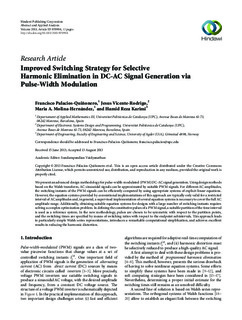Improved switching strategy for selective harmonic elimination in DC-AC signal generation via pulse-width modulation
Palacios-Quiñonero, Francisco; Vicente-Rodrigo, Jesus; Molina-Hernández, Maria A.; Karimi, Hamid Reza
Original version
Palacios-Quiñonero, F., Vicente-Rodrigo, J., Molina-Hernández, M. A., & Karimi, H. R. (2013). Improved switching strategy for selective harmonic elimination in DC-AC signal generation via pulse-width modulation. Abstract and Applied Analysis, 2013. doi: 10.1155/2013/870904 10.1155/2013/870904Abstract
We present an advanced design methodology for pulse-width-modulated (PWM) DC-AC signal generation. Using design methods based on the Walsh transform, AC sinusoidal signals can be approximated by suitable PWM signals. For different AC amplitudes, the switching instants of the PWM signals can be efficiently computed by using appropriate systems of explicit linear equations. However, the equation systems provided by conventional implementations of this approach are typically only valid for a restricted interval of AC amplitudes and, in general, a supervised implementation of several equation systems is necessary to cover the full AC amplitude range. Additionally, obtaining suitable equation systems for designs with a large number of switching instants requires solving a complex optimization problem. In defining the constitutive pulses of a PWM signal, a suitable partition of the time interval is used as a reference system. In the new methodology, pulses are chosen to be symmetric with respect to the partition points, and the switching times are specified by means of switching ratios with respect to the endpoint subintervals. This approach leads to particularly simple Walsh series representations, introduces a remarkable computational simplification, and achieves excellent results in reducing the harmonic distortion.
Description
Published version of an article in the journal: Abstract and Applied Analysis. Also available from the publisher at: http://dx.doi.org/10.1155/2013/870904 Open Access
